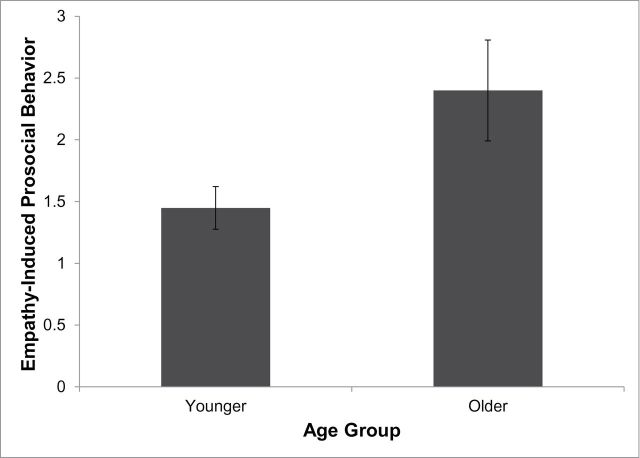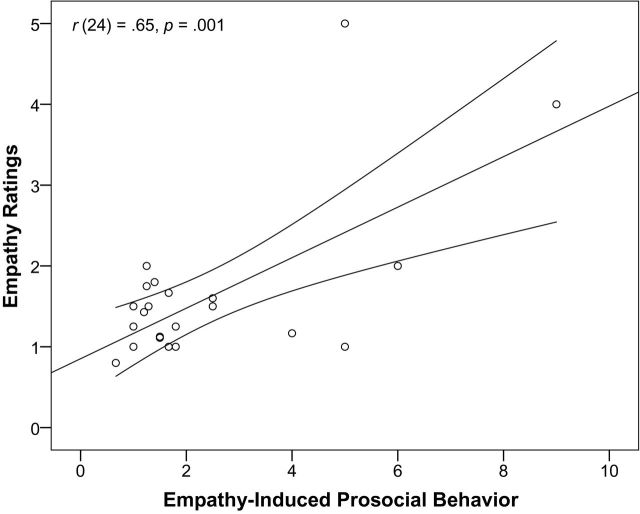Abstract
Objectives. Although empathy is a well-established motivation in younger adults for helping others, it is not known whether this extends to aging. Prioritization of socioemotional goals with age may increase the salience of helping others (i.e., prosocial behavior), but older adults also experience decreased cognitive empathy. Thus, we investigated age-related differences in relationships among empathy and prosocial behavior.
Method. Participants were 24 younger (M = 19.8 years) and 24 older (M = 77.9 years) healthy adults. Whereas participants believed the study involved playing the dictator game, in reality, state emotional empathy was induced implicitly through a note from an opponent describing their experience with cancer. Prosocial behavior was measured by participants’ monetary offers to that opponent.
Results. Older adults showed greater prosocial behavior due to the empathy induction than younger adults. There was a positive association between state emotional empathy ratings and prosocial behavior in older, but not in younger adults, and preliminary evidence for higher state emotional empathy levels in older adults with higher trait cognitive empathy.
Discussion. This suggests that in contexts relevant to socioemotional goals, older adults may be more motivated than younger adults to help others and state emotional empathy may be a potential mechanism for greater prosocial behavior in aging.
Key Words: Aging, Economic decision making, Empathy, Prosocial.
An extensive body of research supports the idea that older adults prioritize engaging in emotionally meaningful activities (Blanchard-Fields, 2007; Carstensen, Gottman, & Levenson, 1995), thought to be a consequence of realizing their remaining time is limited (socioemotional selectivity theory; Carstensen, Isaacowitz, & Charles, 1999). Spending time with close others (Carstensen, 1992; Carstensen et al., 1995, 1999) and helping people in need, prosocial behavior (Newman, Vasudev, & Onawola, 1985), are activities that may increase older adults’ well-being and emotional fulfillment. In younger adults, state and trait emotional empathy is associated with prosocial behavior and relationship satisfaction (Batson, Duncan, Ackerman, Buckley, & Birch, 1981; Batson, O’Quin, Fultz, Vanderplas, & Isen, 1983; Coke, Batson, & McDavis, 1978; Davis & Oathout, 1987). Thus, there is rationale to investigate emotional empathy as a potential mechanism for prosocial behavior in late life. There is growing evidence that older adults may have poorer cognitive empathy than younger adults (adopting the perspective of others to understand their thoughts and feelings; Davis, 1980), but their emotional empathy (sympathy or vicarious experience of others’ emotions; Batson et al., 1983; Davis, 1980) may not differ as a function of age (Bailey, Henry, & Von Hippel, 2008; Beadle et al., 2012; Sullivan & Ruffman, 2004). However, it is not known how age-related differences in empathy may affect prosocial behavior. Therefore, the present study focuses on understanding relationships between empathy and prosocial behavior in aging, as a means of increasing knowledge about mechanisms leading to greater emotional meaning and well-being in late life.
Each component of empathy can be measured as a trait through questionnaires assessing the frequency of empathic feelings or thoughts experienced in daily life (Baron-Cohen & Wheelwright, 2004; Davis, 1980; Mehrabian, 2000). Furthermore, emotional empathy can also be measured as a state, or momentary emotional experience, elicited by an empathy-inducing event, such as viewing someone suffering from physical distress (Batson et al., 1981).
Few studies have examined empathy in aging (Bailey et al., 2008; Beadle et al., 2012; Phillips, MacLean, & Allen, 2002; Richter & Kunzmann, 2011; Sze, Gyurak, Goodkind, & Levenson, 2012). Older adults reported poorer trait cognitive empathy than younger adults on two standard trait measures of empathy (Interpersonal Reactivity Index, Empathy Quotient), but there were no significant age differences on trait emotional empathy (Bailey et al., 2008; Beadle et al., 2012). Using a different measure of trait emotional empathy (Questionnaire Measure of Emotional Empathy; Mehrabian & Epstein, 1972), another study also found trait emotional empathy to be similar in younger and older adults, after controlling for intelligence and education (Phillips et al., 2002). Theory of mind, the detection of the mental states of others, is similar to cognitive empathy and older adults also perform more poorly in this domain than younger adults (for review, see Moran, 2013). State emotional empathy in aging has been investigated in two studies and both have found that older adults report higher state emotional empathy than younger adults in response to viewing empathy-eliciting film clips (Richter & Kunzmann, 2011; Sze et al., 2012). Taken together, this research suggests that older adults may have lower levels of trait cognitive empathy and higher state emotional empathy than younger adults but equivalent levels of trait emotional empathy.
Empathy is purported to be a critical psychological motivation for prosocial behaviors in younger adulthood (Batson, 2010; Batson et al., 1981; Coke et al., 1978), as suggested by the empathy–altruism hypothesis, and thus serves as a candidate mechanism to explain prosocial behavior in late life. To understand relationships between empathy and prosocial behavior, previous studies have induced empathy through scenarios depicting others’ suffering (e.g., videos, notes) and have measured resulting state emotional empathy and prosocial behavior (Batson, 1991; Batson et al., 1983). A technique for eliciting higher levels of state emotional empathy has been for individuals to use cognitive empathy to imagine the feelings of others. (Batson & Moran, 1999; Coke et al., 1978). One study specifically examined how an empathy induction influences prosocial behavior in aging (Sze et al., 2012). In response to an empathy induction (watching videos), older adults reported greater state emotional empathy and showed greater prosocial behavior through charitable donations than younger adults (Sze et al., 2012). Whereas previous research suggests that greater cognitive empathy may elicit higher levels of state emotional empathy in younger adults, this relationship has not been examined in older adults.
Prosocial behavior can be measured in a controlled manner by assessing an individual’s behavior toward opponents on economic games. Younger adults induced to feel more empathy exhibit greater prosocial behavior on economic games, as demonstrated by their higher levels of cooperation or generosity toward opponents (Barraza & Zak, 2009; Batson et al., 1995; Batson & Moran, 1999). However, measuring prosocial behavior on economic games in the absence of an empathy induction likely also assesses one’s propensity toward treating others fairly (Bolton, Katok, & Zwick, 1998; Singer & Steinbeis, 2009). An empathy-inducing context seems to be important for revealing age-related differences in prosocial behavior, as younger and older adults did not differ in their offer amounts on the dictator game in the absence of an empathy induction (Roalf, Mitchell, Harbaugh, & Janowsky, 2012).
The present study investigates age-related differences in relationships between state emotional empathy, trait cognitive empathy, and prosocial behavior through an economic game while accounting for baseline state emotional empathy and prosocial behavior. To increase ecological validity, empathy was induced and prosocial behavior was measured implicitly. Specifically, empathy was induced by reading a note from an opponent who was thought to have cancer. Prosocial behavior was measured through donations on the dictator game to the opponent purportedly suffering from cancer versus a neutral opponent.
It was predicted that (a) older adults would show greater prosocial behavior in response to an empathy induction than younger adults and (b) there would be a stronger relationship between state emotional empathy ratings and prosocial behavior in older adults because empathy-eliciting scenarios may have particular emotional salience for older adults due to their focus on experiencing emotional meaning through relationships with others. Finally, it was hypothesized that older adults with high trait cognitive empathy would have higher state emotional empathy ratings and greater prosocial behavior than older adults with lower trait cognitive empathy based on research demonstrating that cognitive empathy increases state emotional empathy levels in response to empathy inductions in younger adults.
METHOD
Participants
A total of 48 younger (18–26 years) and older (67–93 years) adults participated in this study, with 24 people in each group. Younger participants were primarily undergraduate students. Older participants (and some younger participants) responded to a community advertisement. Screening procedures ensured participants were free of neurological and psychiatric disease, and substance abuse, and that older adults were cognitively oriented (≥26 on the Mini-Mental State Examination; Folstein, Folstein, & McHugh, 1975). Participants completed Shipley Vocabulary (Shipley, 1986), and the Digit Comparison Task, as a speed of processing measure (Hedden et al., 2002; see Table 1). Participants were either compensated with course credit or $10 per hour. In the older group, all participants were paid for participating, and in the younger group, 15 participants were paid (9 received course credit). Participants provided written informed consent in accordance with the Brandeis University Institutional Review Board and were debriefed about the deception.
Table 1.
Demographic and Cognitive Characteristics Across Age Groups
| Younger | Older | p Value | d | |
|---|---|---|---|---|
| M (SD) | M (SD) | |||
| Age (years) | 19.83 (2.01) | 77.92 (7.71) | <.001 | 10.53 |
| Gender | 15 Female | 15 Female | ||
| Education (years) | 12.42 (1.25) | 15.50 (2.32) | <.001 | 1.69 |
| Frequency in a relationship or married (%) | 2 (8.30%) | 10 (41.70%) | .01 | 2.10 |
| Income level (number of participants, %) | ||||
| $0–60,000 | 23 (95.80%) | 11 (45.80%) | <.001 | 3.77 |
| $60,001 and greater | 1 (4.20 %) | 11 (45.80%) | ||
| Digit Comparison Total | 88.08 (16.31) | 58.42 (10.64) | <.001 | 2.20 |
| Shipley Vocabulary | 31.71 (5.13) | 36.33 (2.91) | <.001 | 1.13 |
| MMSE | NA | 29.00 (1.10) | NA | NA |
Notes. Independent t tests were conducted to compare younger and older adults on these variables, and Pearson chi-square analyses were used when variables were categorical (e.g., frequencies of relationship status, income level). For the “In a relationship or married variable”: those who were not in a relationship or married were either single, widowed, or divorced. d = Cohen’s standard effect size; MMSE = Mini-Mental State Examination; SD = standard deviation.
Implicit Empathy Induction
Participants believed they would play a game against a series of two opponents that involved deciding how to split $10 (the dictator game). They could obtain money in addition to their hourly participation compensation depending on their game behavior and would be paid in cash after the experiment for one randomly selected round ($1–9). In reality, participants played against two confederates rather than actual opponents.
Participants were informed that the study would involve communicating with their opponents through written notes and playing the game with paper tokens delivered in a sealed envelope by the Research Assistant but would never meet their opponents. To determine who would write the note, participants selected their role out of a basket before the game (the selection was rigged; participants always chose the role of the reader of the note). Participants were told that those selected to write a note would describe an event from the past week to share with their opponent prior to the game (see Supplementary Data). Participants would have 7minutes to write the note before placing it in a sealed envelope to be delivered to the other participant to read before the game began by the Research Assistant (who did not have access to the note). In actuality, these notes were prepared ahead of time by lab members.
Participants were informed that their current mood state would be assessed at random intervals throughout the study with a brief questionnaire in order to measure the effect of playing the games over time. In fact, these questionnaires assessed empathy and other relevant emotions (e.g., personal distress and sadness) at baseline and after each induction in order to measure the degree to which the induction changed the participants’ emotional state.
Empathy Induction
Neutral and empathic states were induced using handwritten notes that were thought to be from their opponents in the game (see Supplementary Data). The order of the neutral and empathic inductions was counterbalanced, such that in each age group, 12 participants received the neutral induction first (12 received the empathy induction first). The notes followed a similar design of previous empathy induction studies involving economic games in younger adults (Batson et al., 1995; Batson & Moran, 1999). The empathy induction note describes one opponent’s experience with skin cancer, whereas the neutral induction note details the other opponent’s daily errands (see Supplementary Data).
Designed for the purpose of eliciting empathy in both younger and older adults, we selected a note topic that both age groups could relate to, that of skin cancer, because both younger and older adults are affected by this disease. We had middle-aged adults handwrite the notes because their age was in between that of the two age groups. We assessed participant perceptions of the notes in a postexperimental questionnaire (see Results, Assessment of Manipulation Checks section).
Prosocial Behavior
Participants served in the role of the proposer on the dictator game and decided how to split $10 with their opponents, as indicated by $1 paper tokens. They were instructed that their offers must fit these criteria: (a) include $1 increments and (2) range from $1 to $9. Participants made one offer in each condition to one opponent and were told that their opponent must accept their offer.
The effect of the empathy induction on prosocial behavior was measured by participants’ dictator game offers immediately following the empathy induction. Because it is well established that there are baseline individual differences in behavior on economic games (Scheres & Sanfey, 2006), we accounted for this by computing a ratio variable that compared prosocial behavior immediately after the empathy induction with baseline prosocial behavior after the neutral induction (Ratio Offer = empathy induction game offers/neutral induction game offers). Subsequent analyses refer to the Ratio Offer variable rather than raw offers. Primary analyses were conducted with the entire sample and analyses were rerun for outliers (>2.5 SD) within each age group, which were removed to test that significant effects were upheld.
Measures
State emotional empathy ratings
Participants completed a questionnaire that measured their state levels of emotional empathy, personal distress, and basic emotions at baseline and immediately after reading each note. For each emotion item on the scale, participants rated from 1 (very slightly or not at all) to 5 (extremely), in response to the prompt, “Indicate to what extent you feel this way right now, that is, at the present moment.” Both the rating scale and prompt were adopted from the Positive and Negative Affective Schedule (PANAS) questionnaire (Watson & Clark, 1994). State emotional empathy was measured by two items (“sympathetic”; “compassionate”) drawn from the emotional response scale, a well-validated measure of state emotional empathy (Batson, 1987, 1991). To measure the specificity of the empathy induction for eliciting empathy in comparison with personal distress, we also measured personal distress through the items “upset” and “distressed” from the emotional response scale. State levels of basic emotions were measured by PANAS items (Watson & Clark, 1994) corresponding to sadness (“sad”; “downhearted”), hostility (“hostile”; “angry”), and joviality (“happy”; “joyful”).
In order to account for individual variability in baseline emotion and empathy ratings, we computed a ratio for each emotion category (emotional empathy, personal distress, sadness, hostility, and joviality) in which the average of the ratings per category immediately after the empathy induction was divided by the average of the participants’ baseline ratings immediately prior to the empathy induction (Ratio Ratings: After/Before Empathy Induction ratings per emotion category). Henceforth, all analyses involving state levels of emotional empathy, personal distress, and basic emotions allude to this Ratio Ratings variable instead of raw ratings.
Induction manipulation check
Participants completed a postexperimental questionnaire assessing perceptions of the notes on these dimensions: valence, arousal, believability, and age and gender of the note writer. Believability was assessed through the item: “While you were reading the first (second) note you received, did you think the note was from one of the other participants in the study?” Participants responded to each question by circling their answer on a scale ranging from (−3) = no, to (0) = not sure, to (3) = yes. For the first 7 participants, the believability items included three categorical responses: “no did not believe,” “yes believed,” or “not sure.” These responses were recoded to be consistent with the rest of the participants such that no = −3, yes = 3, and not sure = 0. We also measured whether the participant had personally experienced skin cancer.
RESULTS
Assessment of Manipulation Checks
There were no significant age differences in perceptions of the empathy induction note for valence, arousal, vividness, gender, or believability (see Supplementary Table 1). The note writer was perceived as younger by the younger group, relative to the older group (Supplementary Table 1). In other words, both age groups perceived the note writer as being closer in age to their own group. There were too few participants with personal experience with skin cancer to allow for analysis. Only a very small proportion of participants had a personal history of skin cancer (younger group: 1 out of 24; older group: 5 out of 24), and thus statistical analyses were not conducted on this question.
Age-Related Differences in Empathy-Induced Prosocial Behavior
To assess age-related differences in how state emotional empathy affects prosocial behavior, an independent samples t test compared younger with older adults on their prosocial behavior due to the empathy induction. This analysis revealed a significant age difference, whereby older adults, compared with younger adults, gave relatively higher offers in response to the empathy induction than in response to the neutral induction (see Figure 1 and Table 2; t(46) = 2.15, p = .04, d = .6). When outliers (>2.5 SD) within each age group were removed, the comparison of younger with older adults on prosocial behavior was still significant [t(44) = 2.61, p = .01, d = .8]. Because some younger adults were paid for participating in the study (n = 15), whereas others received course credit (n = 9), we examined whether this affected their degree of prosocial behavior. There were no significant differences in prosocial behavior between these two subgroups of younger adults [t(22) = .03, p = .98, d = .01].
Figure 1.
Age-related differences in prosocial behavior as a function of the empathy induction. Prosocial behavior represented as a ratio of dollars offered to their game opponent on the dictator game in response to the empathy induction divided by their response to the neutral induction (which served as a baseline). Error bars reflect standard error of the mean.
Table 2.
Prosocial Behavior by Age Group and Induction Type
| Type of induction | Younger | Older | ||
|---|---|---|---|---|
| M | SD | M | SD | |
| Neutral | 3.79 | 1.61 | 3.79 | 1.86 |
| Empathy | 5.04 | 2.20 | 6.29 | 1.88 |
Note. Values for the neutral and empathy conditions reflect the mean dollar amount given by each group in each condition on the dictator game. SD = standard deviation.
We examined whether prosocial behavior was affected by believability ratings or the order of the emotion inductions by conducting a univariate analysis of covariance comparing age-related differences in prosocial behavior with believability as a covariate; age differences were still significant, F(2,45) = 4.43, p = .04,  = .09, and there was no effect of believability, F(2,45) = .32, p = .58,
= .09, and there was no effect of believability, F(2,45) = .32, p = .58,  = .01. With induction order as a covariate, the age group effect found previously was again demonstrated, F(2,45) = 4.52, p = .04,
= .01. With induction order as a covariate, the age group effect found previously was again demonstrated, F(2,45) = 4.52, p = .04,  = .09, but there were no significant effects involving order, F(2,45) = .19, p = .67,
= .09, but there were no significant effects involving order, F(2,45) = .19, p = .67,  = .004.
= .004.
Aging and State Emotional Empathy
Next, we assessed age differences in state levels of emotional empathy in response to the empathy induction (using the Ratio Ratings variable to account for baseline levels) in comparison with state levels of personal distress and basic emotions (for descriptive statistics, please see Table 3). We conducted a multivariate analysis of variance that examined the effect of age group (younger, older) on state levels of the various emotion categories (empathy, personal distress, sadness, joviality, and hostility). A multivariate test of age group revealed no significant differences, F(5,42) = .66, p = .66,  = .07, and there were no age differences for the emotion categories [empathy: F(1,46) = .03, p = .87,
= .07, and there were no age differences for the emotion categories [empathy: F(1,46) = .03, p = .87,  = .001; personal distress: F(1,46) = 1.07, p = .31,
= .001; personal distress: F(1,46) = 1.07, p = .31,  = .02; sadness: F(1,46) = .64, p = .43,
= .02; sadness: F(1,46) = .64, p = .43,  = .01; hostility: F(1,46) = 1.00, p = .32,
= .01; hostility: F(1,46) = 1.00, p = .32,  = .02; joviality: F(1,46) = .29, p = .59,
= .02; joviality: F(1,46) = .29, p = .59,  = .01]. With removal of outliers (>2.5 SD) within each age group, there was still no significant effect of age group on state emotion ratings, F(5,40) = .47, p = .80,
= .01]. With removal of outliers (>2.5 SD) within each age group, there was still no significant effect of age group on state emotion ratings, F(5,40) = .47, p = .80,  = .06. We also assessed whether payment for participation in the younger group (vs course credit) affected state emotional empathy ratings and found no significant difference [t(22) = .85, p = .40, d = .4]. There were no significant effects of induction order or believability on the age group comparisons of emotion ratings [induction order: F(5,41) = .69, p = .63,
= .06. We also assessed whether payment for participation in the younger group (vs course credit) affected state emotional empathy ratings and found no significant difference [t(22) = .85, p = .40, d = .4]. There were no significant effects of induction order or believability on the age group comparisons of emotion ratings [induction order: F(5,41) = .69, p = .63,  = .08; believability: F(5,41) = .63, p = .68,
= .08; believability: F(5,41) = .63, p = .68,  = .07].
= .07].
Table 3.
Self-Reported Empathy and Emotion as a Function of Age Group
| Younger | Older | ||||
|---|---|---|---|---|---|
| Type of measure | Measure | M | SD | M | SD |
| Trait: empathy | IRI-PT | 20.75 | 4.83 | 17.26 | 4.54 |
| IRI-EC | 20.92 | 4.99 | 21.31 | 3.38 | |
| State: Ratio Ratings (per emotion category) | Empathy | 1.65 | 0.87 | 1.60 | 0.97 |
| Sadness | 2.03 | 1.12 | 1.79 | 0.91 | |
| Personal distress | 1.35 | 0.56 | 1.59 | 0.97 | |
| Hostility | 1.01 | 0.18 | 1.07 | 0.21 | |
| Joviality | 0.75 | 0.24 | 0.79 | 0.20 | |
Notes. Descriptive means and SD are reported for the younger and older adult age groups per empathy measure. For the IRI questionnaire, participants’ sum on each subscale (either PT or EC) is depicted. Ratio Ratings: for each emotion category (empathy, personal distress, sadness, hostility, and joviality), a ratio was computed separately such that the participants’ average rating after the empathy induction was divided by their average rating immediately prior to the empathy induction. IRI-EC = Interpersonal Reactivity Index, Empathic Concern subscale; IRI-PT = Interpersonal Reactivity Index, Perspective Taking subscale; SD = standard deviation.
Relationship Between State Emotional Empathy and Prosocial Behavior
Because we found age-related differences in prosocial behavior due to the empathy induction, we examined whether state emotional empathy might partially explain these differences. Although we did not find age-related differences in self-reported state emotional empathy, F(1,46) = .03, p = .87,  = .001, there could be age differences in the relationship between state emotional empathy and prosocial behavior.
= .001, there could be age differences in the relationship between state emotional empathy and prosocial behavior.
We compared the age groups on the strength of the correlation coefficient between prosocial behavior and state emotional empathy. First, we established that the two variables were positively correlated in the entire group [r(48) = .41, p = .004]. Comparing the correlation coefficients, there was a strong, positive relationship between the two variables for the older group [see Figure 2; r(24) = .65, p = .001], but no significant relationship among younger adults [r(24) = −.03, p = .91]. The relationship between the two variables differed significantly between the two age groups [z(46) = 2.61, p = .01, d = .8].
Figure 2.
Among the older adult group, the relationship between empathy ratings (Ratio Empathy Ratings = empathy induction/baseline) and empathy-induced prosocial behavior (Ratio Offer = empathy induction/neutral induction baseline) is represented.
To directly compare our results with previous studies of younger adults that did not consider individual baseline levels of state emotional empathy or prosocial behavior, we conducted an exploratory analysis examining the relationship between state emotional empathy ratings and prosocial behavior, without accounting for baseline levels in each age group. Consistent with previous research, younger adults in the present sample showed a positive correlation between empathy ratings and prosocial behavior [r(24) = .58, p = .003], but there was no significant relationship found in older adults [r(24) = .11, p = .60].
State Emotional Empathy, Prosocial Behavior, and Trait Cognitive Empathy
We compared younger and older adult participants’ scores on the measure of trait cognitive (Interpersonal Reactivity Index, Perspective Taking subscale [IRI-PT]) and emotional empathy (Interpersonal Reactivity Index, Empathic Concern subscale; Davis, 1980). Older adults reported lower trait cognitive empathy than younger adults [t(45) = 2.55, p = .01, d = .8; see Table 2], but there was no significant age difference in trait emotional empathy [t(45) = .32, p = .75, d = .1].
Because the older group had lower cognitive empathy (IRI-PT) scores than the younger group, we investigated the degree to which trait cognitive empathy scores were related to prosocial behavior and state emotional empathy ratings. Participants were categorized as either having low or high trait cognitive empathy within each age group based upon the median score within their respective groups (older group: n = 13 for low trait cognitive empathy, n = 10 for high trait cognitive empathy; younger group: n = 12 for low and high trait cognitive empathy). Among older adults, those with higher trait cognitive empathy had marginally higher state emotional empathy ratings (with a difference of large effect size) than those with lower trait cognitive empathy [t(21) = 1.88, p = .07, d = .8; high trait cognitive empathy: M = 2.00, SD = 1.39; lower trait cognitive empathy: M = 1.26, SD = .28]. There was no significant effect of trait cognitive empathy on prosocial behavior, but the medium effect size suggests that studying a larger sample may reveal significant differences between the subgroups [t(21) = 1.05, p = .31, d = .5]. In the younger group, there were no significant effects of trait cognitive empathy [state emotional empathy: t(22) = .49, p = .63, d = .2; prosocial behavior: t(22) = .82, p = .42, d = .4].
Exploratory Analysis: Income, Prosocial Behavior, and State Emotional Empathy
Personal monetary resources may also have affected how participants responded to the empathy induction, and therefore we examined how household income (defined as the total income made by oneself and, if applicable, one’s spouse/partner) affected state emotional empathy ratings and prosocial behavior. Income was dichotomized into low (≤$60,000) or high income (>$60,000). Older adults had higher household incomes than younger adults (see Table 1). Because only one younger adult had an income of $60,000 or greater (younger adults were primarily full-time students), we restricted analyses to the older group (n = 11 per subgroup, see Table 1). We investigated whether higher income levels in the older group were related to a greater degree of prosocial behavior or state emotional empathy in the empathy condition.
There was a marginally significant difference in state emotional empathy ratings as a function of income [t(20) = 1.94, p = .07, d = .9], but not prosocial behavior [t(20) = 1.35, p = .19, d = .6]. On average, the subgroup of older adults with lower income had higher state emotional empathy ratings (M = 2.04, SD = 1.28) than the higher income subgroup (M = 1.26, SD = .34). This finding provides preliminary support that lower income may be associated with greater state emotional empathy in response to an empathy induction than higher income in older adults.
DISCUSSION
Our first prediction that older adults would show greater prosocial behavior than younger adults in response to an empathy induction was supported. Secondly, we found a stronger relationship between state emotional empathy ratings and prosocial behavior in older than in younger adults. Finally, there was partial support for the prediction that older adults with higher trait cognitive empathy would report greater state emotional empathy ratings and prosocial behavior in response to an empathy induction than older adults with lower trait cognitive empathy. Specifically, we found a trend level effect that older adults with higher trait cognitive empathy had greater state emotional empathy ratings after the empathy induction than older adults with lower trait cognitive empathy, but there was no significant effect of trait cognitive empathy on prosocial behavior.
Our finding that older adults showed greater prosocial behavior in response to an empathy induction is consistent with the study by Sze and colleagues (2012), which found that older adults gave greater charitable donations than younger and middle-aged adults in response to a video empathy induction. In fact, the age-related difference in prosocial behavior was of similar magnitude, with older adults giving approximately $1.20 more than younger adults in both studies. Our empathy induction is more comparable with the distressing empathy induction from the Sze and colleagues study, which depicted photos of suffering people in comparison with the uplifting empathy induction including photos of children with autism enjoying a surf camp. Interestingly, in the present study, the dollar amount given by the older adults was greater than that of the Sze and colleagues study in the distressing condition ($6.29 on a $1–9 scale vs $3.84 on a $0–10 scale, respectively), perhaps because the donation was made to a suffering person in closer social proximity (down the corridor vs a distant charity).
The lack of significant age-related differences in prosocial behavior in response to the neutral induction highlights the importance of social context in eliciting greater prosocial behavior in older adults. Prior studies without an empathy induction (Roalf et al., 2012) did not find age-related differences in offer amounts between younger and older adults on the dictator game, and offer amounts are comparable with the present study’s neutral condition (Roalf: younger: M = 4.00, older: M = 4.23; Present: younger: M = 3.79, older: M = 3.79). The results suggest that the empathy induction in the present study increased the relevance of prosocial behavior in both age groups, demonstrated by higher offers in the empathy than neutral condition. However, social context may be even more important in the older group because the difference was more pronounced.
The context (empathy induction vs no induction), type of game (ultimatum vs dictator), and game role (proposer, person who makes offers, vs responder, person who accepts or rejects offers) may also affect older adults’ prosocial behavior on economic games. In the present study, older adults served as the proposer on the dictator game and gave more money than younger adults in the empathy condition, thus exhibiting more prosocial behavior only in the empathy context. In the absence of an empathy induction, older adults also gave greater offers on the ultimatum game than younger adults in a previous study (Bailey, Ruffman, & Rendell, 2013). However, when older adults are in the role of the responder on the ultimatum game, there are mixed findings, with some studies reporting that they reject more “unfair” offers (offers less than half of the total) than younger adults, suggesting less prosocial behavior in this particular game (Harle & Sanfey, 2012; Roalf et al., 2012). In another study, when older adults were responders in the ultimatum game, a subgroup with higher trait cognitive empathy rejected more “unfair” offers than a subgroup of younger adults with higher trait cognitive empathy (Beadle et al., 2012). This finding suggests that when there is no empathy induction, older adults in the role of the responder on the ultimatum game who have higher trait cognitive empathy may behave in a less prosocial manner than younger adults with higher trait cognitive empathy. In future research, it may be useful to further isolate effects of context, game type, and game role when measuring prosocial behavior in older adults, perhaps through tasks that can assess these additional variables, for example, the Zurich Prosocial Game (Leiberg, Klimecki, & Singer, 2011).
Older adults’ greater prosocial behavior than younger adults in response to an empathy induction is consistent with the theory that older adults prioritize socioemotional goals (Carstensen et al., 1999), and hearing about another’s suffering may be an emotionally salient stimulus. An enhanced response by older adults to socioemotional information over nonsocial or knowledge-related information has been previously demonstrated in other cognitive domains. For example, older adults are better able to attend to emotional than nonemotional stimuli in conditions involving interference (Samanez-Larkin, Robertson, Mikels, Carstensen, & Gotlib, 2009), and their source memory for impressions related to socioemotional information is similar to younger adults, despite their poorer memory for nonsocial information (Cassidy & Gutchess, 2012). Older adults engage in behaviors that facilitate positive social interactions (Birditt & Fingerman, 2005; Blanchard-Fields, 2007; Carstensen et al., 1995). In response to photos of social affiliation, older adults show greater recruitment of the precuneus than younger adults, a brain region implicated in referencing self-relevant information (Beadle, Yoon, & Gutchess, 2012).
We found that state emotional empathy ratings were related to prosocial behavior in response to the empathy induction, consistent with the younger (Batson, 1987; Batson & Moran, 1999; Coke et al., 1978) and older adult literatures (Sze et al., 2012). Extending prior research, when the age groups were investigated separately, it was found that state emotional empathy and prosocial behavior were only significantly related in the older group. Our analysis may account for this discrepancy. When a relationship between state emotional empathy and prosocial behavior has been found in younger adults, baseline levels of empathy and prosocial behavior typically were not considered (Batson et al., 1983; Batson & Moran, 1999). Because there are significant individual differences in empathy (Davis, 1980; Mehrabian, 2000) and prosocial behavior (Scheres & Sanfey, 2006), accounting for baseline levels allows for a more direct comparison with an aging study using an empathy induction (Sze et al., 2012). Sze and colleagues (2012) used baseline levels of empathic concern as a covariate in all analyses of state emotional empathy but did not assess baseline prosocial behavior. To compare our results with previous younger adult studies, we examined the relationship between state emotional empathy and prosocial behavior without baseline levels in an exploratory analysis and found a positive correlation in younger but not in older adults. Taken together, this indicates that it may be important to consider baseline levels of state emotional empathy and prosocial behavior when measuring empathy in older adults, whereas for younger adults, momentary ratings may be more relevant.
In contrast to Sze and colleagues (2012), we did not find age-related differences in state emotional empathy ratings. This may be due to differences in trait cognitive and emotional empathy reported by older adults across the two studies. In the present study, older adults reported lower trait cognitive empathy and similar trait emotional empathy levels to younger adults, consistent with previous aging studies (Bailey et al., 2008; Beadle et al., 2012; Phillips et al., 2002), but Sze and colleagues found that older adults had similar levels of trait cognitive empathy and higher trait emotional empathy than younger adults. Instructions to take the perspective of others (utilizing cognitive empathy) have been associated with greater state emotional empathy in response to empathy inductions in younger adults (Batson et al., 1981, 1983; Batson & Moran, 1999; Coke et al., 1978). Therefore, the higher trait cognitive empathy reported by the older adults in the Sze and colleagues sample may have contributed to their higher reported state emotional empathy levels (and the opposite effect may have been true in the present study). This is consistent with our finding of a trend for older adults with higher trait cognitive empathy to have higher ratings of state emotional empathy than older adults with lower trait cognitive empathy. Although we could not test this directly due to our sample size, we speculate that older adults with higher trait cognitive empathy who also have higher state emotional empathy would have increased levels of prosocial behavior in response to an empathy induction based upon the strong, positive relationship between state emotional empathy and prosocial behavior. Therefore, future studies may consider how differences in trait cognitive empathy among older adults may affect state emotional empathy and prosocial behavior.
This study focuses on one type of prosocial behavior (charitable donation), and thus it is important to experimentally test whether inducing empathy results in greater prosocial behavior in aging in other domains such as volunteering one’s time or even physical displays of comfort toward others (e.g., patting one’s arm). Although the present study investigated empathy and prosocial behavior toward strangers, older adults may show more prosocial behaviors toward close others because they may represent more emotionally meaningful social connections. Greater prosocial behavior by older adults in empathy-inducing contexts may also have implications for intergenerational helping behavior. Previous research has shown that greater satisfaction is experienced when other-oriented emotion regulation strategies are used to resolve conflict between mothers and adult daughters (Martini & Busseri, 2010).
This study demonstrates that older adults engage in greater prosocial behavior than younger adults when empathy has been induced but are not simply more generous in their donations at baseline. This suggests, in line with socioemotional selectivity theory (Carstensen et al., 1999), that the socioemotional relevance of the context is important in determining older adults’ prosocial behavior. The experience of empathy may also be a potential mechanism for prosocial behavior in aging based upon our findings that state emotional empathy ratings and prosocial behavior were positively related in response to an empathy induction in older adults. Finally, there is preliminary evidence that trait cognitive empathy may affect the level of state emotional empathy older adults experience in response to an empathy induction. Thus, future research may examine the degree to which trait and state cognitive and emotional empathy and socioemotional relevance may affect prosocial behavior in older adults.
SUPPLEMENTARY MATERIAL
Supplementary material can be found at: http://psychsocgerontology.oxfordjournals.org/
FUNDING
This work was supported by the National Institute on Aging at the National Institute of Health (R21AG032382 to A. H. Gutchess). Postdoctoral fellowship support for J. N. Beadle was received from the National Institute of Health (NS007292 to Brandeis University Neuroscience Program).
CONFLICT OF INTEREST
The authors have no conflicts of interest to disclose.
Supplementary Material
ACKNOWLEDGMENTS
The authors would like to thank Sapir Karli for her assistance with scheduling participants for the study and the Aging, Culture, and Cognition Lab for feedback on the empathy induction stimuli.
References
- Bailey P. E., Henry J. D., Von Hippel W. (2008). Empathy and social functioning in late adulthood. Aging & Mental Health, 12, 499–503. 10.1080/13607860802224243 [DOI] [PubMed] [Google Scholar]
- Bailey P. E., Ruffman T., Rendell P. G. (2013). Age-related differences in social economic decision making: The ultimatum game. The Journals of Gerontology, Series B: Psychological Sciences and Social Sciences, 68, 356–363. 10.1093/geronb/gbs073 [DOI] [PubMed] [Google Scholar]
- Baron-Cohen S., Wheelwright S. (2004). The empathy quotient: An investigation of adults with Asperger syndrome or high functioning autism, and normal sex differences. Journal of Autism and Developmental Disorders, 34, 163–175. 10.1023/B: JADD.0000022607.19833.00 [DOI] [PubMed] [Google Scholar]
- Barraza J. A., Zak P. J. (2009). Empathy toward strangers triggers oxytocin release and subsequent generosity. Annals of the New York Academy of Sciences, 1167, 182–189. 10.1111/j.1749-6632. 2009.04504.x [DOI] [PubMed] [Google Scholar]
- Batson C. D. (1987). Prosocial motivation: Is it ever truly altruistic? In L. Berkowitz (Ed.), Advances in experimental social psychology (Vol. 20, pp. 65–122). San Diego, CA: Academic Press. 10.1016/S0065-2601(08)60412-8 [Google Scholar]
- Batson C. D. (1991). The altruism question: Toward a social-psychological answer. Hillsdale, NJ: Lawrence Erlbaum Associates. [Google Scholar]
- Batson C. D. (2010). Empathy-induced altruistic motivation. In M. Mikulincer & P. R. Shaver (Eds.), Prosocial motives, emotions, and behavior: The better angels of our nature (pp. 15–34). Washington, DC: American Psychological Association. 10.1037/12061-001 [Google Scholar]
- Batson C. D., Batson J. G., Todd R. M., Brummett B. H., Shaw L. L., Aldeguer C. M. R. (1995). Empathy and the collective good: Caring for one of the others in a social dilemma. Journal of Personality and Social Psychology, 68, 619–631. 10.1037/0022-3514.68.4.619 [Google Scholar]
- Batson C. D., Duncan B. D., Ackerman P., Buckley T., Birch K. (1981). Is empathic emotion a source of altruistic motivation? Journal of Personality and Social Psychology, 40, 290–302. 10.1037/0022-3514.40.2.290 [Google Scholar]
- Batson C. D., Moran T. (1999). Empathy-induced altruism in a prisoner’s dilemma. European Journal of Social Psychology, 29, 909–924. 10.1002/(SICI)1099-0992(199911)29:7<909:: AID-EJSP965>3.0.CO;2-L [Google Scholar]
- Batson C. D., O’Quin K., Fultz J., Vanderplas M., Isen A. M. (1983). Influence of self-reported distress and empathy on egoistic versus altruistic motivation to help. Journal of Personality and Social Psychology, 45, 706–718. 10.1037/0022-3514.45.3.706 [Google Scholar]
- Beadle J. N., Paradiso S., Kovach C., Polgreen L., Denburg N. L., Tranel D. (2012). Effects of age-related differences in empathy on social economic decision-making. International Psychogeriatrics, 24, 822–833. 10.1017/S1041610211002547 [DOI] [PMC free article] [PubMed] [Google Scholar]
- Beadle J. N., Yoon C., Gutchess A. H. (2012). Age-related neural differences in affiliation and isolation. Cognitive, Affective & Behavioral Neuroscience, 12, 269–279. 10.3758/s13415-012-0085-y [DOI] [PMC free article] [PubMed] [Google Scholar]
- Birditt K. S., Fingerman K. L. (2005). Do we get better at picking our battles? Age group differences in descriptions of behavioral reactions to interpersonal tensions. The Journals of Gerontology, Series B: Psychological Sciences and Social Sciences, 60, P121–P128. 10.1093/geronb/60.3.P121 [DOI] [PubMed] [Google Scholar]
- Blanchard-Fields F. (2007). Everyday problem solving and emotion: An adult developmental perspective. Current Directions in Psychological Science, 16, 26–31. 10.1111/j.1467-8721.2007.00469.x [Google Scholar]
- Bolton G. E., Katok E., Zwick R. (1998). Dictator game giving: Rules of fairness versus acts of kindness. International Journal of Game Theory, 27, 269–299. 10.1007/s001820050072. Retrieved from http://www.springerlink.com/link.asp?id=101791 [Google Scholar]
- Carstensen L. L. (1992). Social and emotional patterns in adulthood: Support for socioemotional selectivity theory. Psychology and Aging, 7, 331–338. 10.1037/0882-7974.7.3.331 [DOI] [PubMed] [Google Scholar]
- Carstensen L. L., Gottman J. M., Levenson R. W. (1995). Emotional behavior in long-term marriage. Psychology and Aging, 10, 140–149. 10.1037/0882-7974.10.1.140 [DOI] [PubMed] [Google Scholar]
- Carstensen L. L., Isaacowitz D. M., Charles S. T. (1999). Taking time seriously. A theory of socioemotional selectivity. The American Psychologist, 54, 165–181. 10.1037/0003-066X.54.3.165 [DOI] [PubMed] [Google Scholar]
- Cassidy B. S., Gutchess A. H. (2012). Social relevance enhances memory for impressions in older adults. Memory, 20, 332–345. 10.1080/09658211.2012.660956 [DOI] [PMC free article] [PubMed] [Google Scholar]
- Coke J. S., Batson C. D., McDavis K. (1978). Empathic mediation of helping: A two-stage model. Journal of Personality and Social Psychology, 36, 752–766. 10.1037/0022-3514.36.7.752 [Google Scholar]
- Davis M. H. (1980). Individual differences in empathy: A multidimensional approach. Dissertation Abstracts International, 40, 3480. [Google Scholar]
- Davis M. H., Oathout H. A. (1987). Maintenance of satisfaction in romantic relationships: Empathy and relational competence. Journal of Personality and Social Psychology, 53, 397–410. 10.1037/0022-3514.53.2.397 [Google Scholar]
- Folstein M. F., Folstein S. E., McHugh P. R. (1975). “Mini-mental state”. A practical method for grading the cognitive state of patients for the clinician. Journal of Psychiatric Research, 12, 189–198. 10.1016/0022-3956(75)90026-6 [DOI] [PubMed] [Google Scholar]
- Harle K. M., Sanfey A. G. (2012). Social economic decision-making across the lifespan: An fMRI investigation. Neuropsychologia, 50, 1416–1424. 10.1016/j.neuropsychologia.2012.02.026 [DOI] [PMC free article] [PubMed] [Google Scholar]
- Hedden T., Park D. C., Nisbett R., Ji L. J., Jing Q., Jiao S. (2002). Cultural variation in verbal versus spatial neuropsychological function across the life span. Neuropsychology, 16, 65–73. 10.1037/0894-4105.16.1.65 [DOI] [PubMed] [Google Scholar]
- Leiberg S., Klimecki O., Singer T. (2011). Short-term compassion training increases prosocial behavior in a newly developed prosocial game. PLoS One, 6, e17798. 10.1371/journal.pone.0017798 [DOI] [PMC free article] [PubMed] [Google Scholar]
- Martini T. S., Busseri M. A. (2010). Emotion regulation strategies and goals as predictors of older mothers’ and adult daughters’ helping-related subjective well-being. Psychology and Aging, 25, 48–59. 10.1037/a0018776; 10.1037/a0018776 [DOI] [PubMed] [Google Scholar]
- Mehrabian A. (2000). Manual for the balanced emotional empathy scale (BEES). Available from Albert Mehrabian, 1130 Alta Mesa Road, Monterey, CA 93940. © 1996–2008 by Albert Mehrabian. [Google Scholar]
- Mehrabian A., Epstein N. (1972). A measure of emotional empathy. Journal of Personality, 40, 525–543. 10.1111/j.1467–6494.1972.tb00078.x [DOI] [PubMed] [Google Scholar]
- Moran J. M. (2013). Lifespan development: The effects of typical aging on theory of mind. Behavioural Brain Research, 237, 32–40. 10.1016/j.bbr.2012.09.020 [DOI] [PubMed] [Google Scholar]
- Newman S., Vasudev J., Onawola R. (1985). Older volunteers’ perceptions of impacts of volunteering on their psychological well-being. Journal of Applied Gerontology, 4, 123–127. 10.1177/073346488500400215 [Google Scholar]
- Phillips L. H., MacLean R. D., Allen R. (2002). Age and the understanding of emotions: Neuropsychological and sociocognitive perspectives. The Journals of Gerontology, Series B: Psychological Sciences and Social Sciences, 57, P526–P530. 10.1093/geronb/57.6.P526 [DOI] [PubMed] [Google Scholar]
- Richter D., Kunzmann U. (2011). Age differences in three facets of empathy: Performance-based evidence. Psychology and Aging, 26, 60–70. 10.1037/a0021138 [DOI] [PubMed] [Google Scholar]
- Roalf D. R., Mitchell S. H., Harbaugh W. T., Janowsky J. S. (2012). Risk, reward, and economic decision making in aging. The Journals of Gerontology, Series B: Psychological Sciences and Social Sciences, 67, 289–298. 10.1093/geronb/gbr099 [DOI] [PMC free article] [PubMed] [Google Scholar]
- Samanez-Larkin G. R., Robertson E. R., Mikels J. A., Carstensen L. L., Gotlib I. H. (2009). Selective attention to emotion in the aging brain. Psychology and Aging, 24, 519–529. 10.1037/a0016952 [DOI] [PMC free article] [PubMed] [Google Scholar]
- Scheres A., Sanfey A. G. (2006). Individual differences in decision making: Drive and Reward Responsiveness affect strategic bargaining in economic games. Behavioral and Brain Functions, 2, 35. 10.1186/1744-9081-2-35 [DOI] [PMC free article] [PubMed] [Google Scholar]
- Shipley W. C. (1986). Shipley institute of living scale. Los Angeles, CA: Western Psychological Services. [Google Scholar]
- Singer T., Steinbeis N. (2009). Differential roles of fairness- and compassion-based motivations for cooperation, defection, and punishment. Annals of the New York Academy of Sciences, 1167, 41–50. 10.1111/j.1749-6632.2009.04733.x [DOI] [PubMed] [Google Scholar]
- Sullivan S., Ruffman T. (2004). Social understanding: How does it fare with advancing years? British Journal of Psychology, 95, 1–18. 10.1348/000712604322779424 [DOI] [PubMed] [Google Scholar]
- Sze J. A., Gyurak A., Goodkind M. S., Levenson R. W. (2012). Greater emotional empathy and prosocial behavior in late life. Emotion, 12, 1129–1140. 10.1037/a0025011 [DOI] [PMC free article] [PubMed] [Google Scholar]
- Watson D., Clark L. A. (1994). The PANAS-X: Manual for the positive and negative affect schedule-expanded form. Iowa City, IA: University of Iowa. [Google Scholar]
Associated Data
This section collects any data citations, data availability statements, or supplementary materials included in this article.




